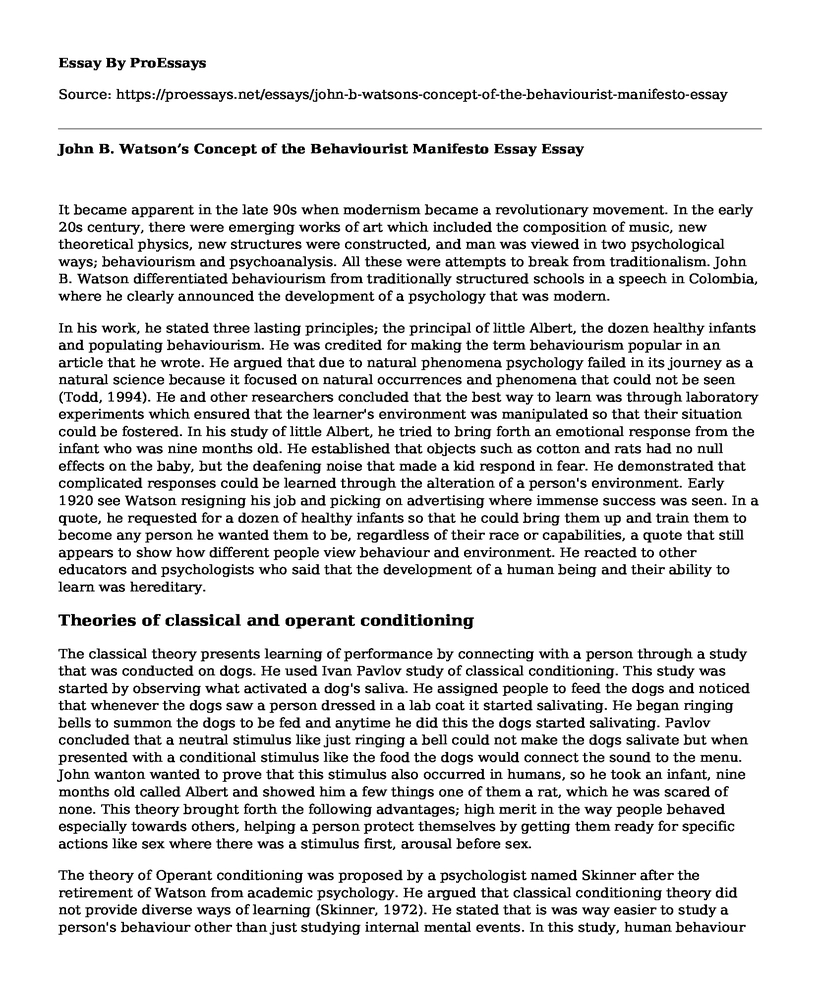It became apparent in the late 90s when modernism became a revolutionary movement. In the early 20s century, there were emerging works of art which included the composition of music, new theoretical physics, new structures were constructed, and man was viewed in two psychological ways; behaviourism and psychoanalysis. All these were attempts to break from traditionalism. John B. Watson differentiated behaviourism from traditionally structured schools in a speech in Colombia, where he clearly announced the development of a psychology that was modern.
In his work, he stated three lasting principles; the principal of little Albert, the dozen healthy infants and populating behaviourism. He was credited for making the term behaviourism popular in an article that he wrote. He argued that due to natural phenomena psychology failed in its journey as a natural science because it focused on natural occurrences and phenomena that could not be seen (Todd, 1994). He and other researchers concluded that the best way to learn was through laboratory experiments which ensured that the learner's environment was manipulated so that their situation could be fostered. In his study of little Albert, he tried to bring forth an emotional response from the infant who was nine months old. He established that objects such as cotton and rats had no null effects on the baby, but the deafening noise that made a kid respond in fear. He demonstrated that complicated responses could be learned through the alteration of a person's environment. Early 1920 see Watson resigning his job and picking on advertising where immense success was seen. In a quote, he requested for a dozen of healthy infants so that he could bring them up and train them to become any person he wanted them to be, regardless of their race or capabilities, a quote that still appears to show how different people view behaviour and environment. He reacted to other educators and psychologists who said that the development of a human being and their ability to learn was hereditary.
Theories of classical and operant conditioning
The classical theory presents learning of performance by connecting with a person through a study that was conducted on dogs. He used Ivan Pavlov study of classical conditioning. This study was started by observing what activated a dog's saliva. He assigned people to feed the dogs and noticed that whenever the dogs saw a person dressed in a lab coat it started salivating. He began ringing bells to summon the dogs to be fed and anytime he did this the dogs started salivating. Pavlov concluded that a neutral stimulus like just ringing a bell could not make the dogs salivate but when presented with a conditional stimulus like the food the dogs would connect the sound to the menu. John wanton wanted to prove that this stimulus also occurred in humans, so he took an infant, nine months old called Albert and showed him a few things one of them a rat, which he was scared of none. This theory brought forth the following advantages; high merit in the way people behaved especially towards others, helping a person protect themselves by getting them ready for specific actions like sex where there was a stimulus first, arousal before sex.
The theory of Operant conditioning was proposed by a psychologist named Skinner after the retirement of Watson from academic psychology. He argued that classical conditioning theory did not provide diverse ways of learning (Skinner, 1972). He stated that is was way easier to study a person's behaviour other than just studying internal mental events. In this study, human behaviour was studied through exposure to different environments, whose responses were named operant. He experimented with a hungry rat which was placed in a box, and it managed to find food by pressing a lever in the table several times.
Watsons study has seen some consistent behaviours in the modern society. For example, he ruled out that when a child cries the mother should not instantly pick the baby up to avoid making the baby get used to the mother's hand, an action that African and the West parents have observed to the latter. He said that is was a way to make the child sleep on their own. Some of these theories were dangerous.
References
Skinner, B. F., Skinner, B. F., Psychologue, E. U., Skinner, B. F., & Skinner, B. F. (1972). Beyond freedom and dignity (No. 04; BF319. 5. O6, S5.). New York: Bantam Books.
Todd, J. T. (1994). What psychology has to say about John B. Watson: Classical behaviourism in psychology textbooks, 1920-1989. Modern perspectives on John B. Watson and classical behaviourism, 75-107.
Cite this page
John B. Watson's Concept of the Behaviourist Manifesto Essay. (2022, Jul 19). Retrieved from https://proessays.net/essays/john-b-watsons-concept-of-the-behaviourist-manifesto-essay
If you are the original author of this essay and no longer wish to have it published on the ProEssays website, please click below to request its removal:
- Diversion Programs Essay Example
- A Review of the European Communication Monitor (ECM) Report 2016 Paper Example
- Essay on Same-Sex Couples: A Debate Raging On Despite Growing Acceptance
- Cultivating Communication: My Experience With a Blunt CEO - Essay Sample
- My Truck Shopping Adventure: Negotiating the Best Price - Report Example
- Example on Reflecting Upon My Lessons
- Sources of Error in Social Science Research: A Comprehensive Analysis Example







